It’s time to make the most of your time away from Wi-Fi and an internet connection. If you want to unplug and enjoy nature, camping is one of the best ways to do it. You can go somewhere with your kids and enjoy beautiful scenery, plenty of fresh air, family bonding time, and twinkling stars. But how do you fill all those hours with some entertainment? Well, one way to do it is to play camping games for kids.
Nowadays, most kids spend more time connected than unplugged. How can you engage them? How can you get them interested in a camping activity?
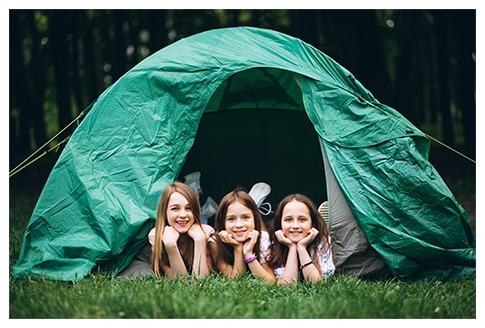
Luckily, there are lots of activities you can try on your camping trip. And don’t worry, we have games for both daytime and nighttime. Some of the ideas include scavenger hunts, treasure searchers, board games, and more. Let’s go and check them out.
1. PRINTABLE ESCAPE ROOM KITS
Fun fact: You don’t have to stay locked in a room for 60 minutes to enjoy the thrilling experience of an escape room. We have moved past the classic escape rooms.
Nowadays, you can turn any area, inside or outside, into an escape room. And how do you do that? Well, with printable escape room kits.
All you have to do is download the ready-to-play kits and then host your own escape room party. Every kit contains puzzles, storylines, and amazing art.
You can play them anywhere and everywhere — just print the game file and set up the area. And the best part is, you can find a themed escape room kit for your camping trip.
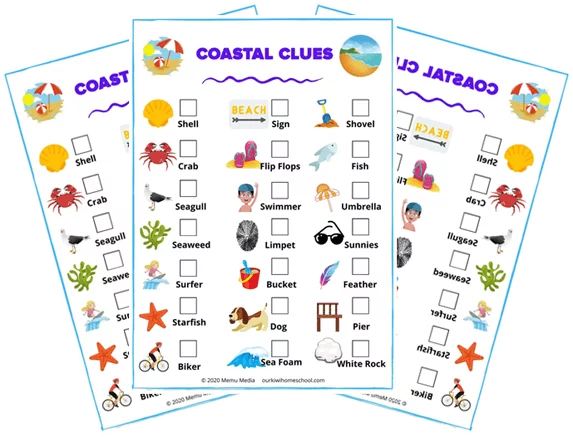
2. Letter Boxing
Letterboxing is an exciting outdoor treasure hunt game that combines elements of navigation, exploration, and creativity. It’s a great way to encourage kids to get outdoors, unplug, and enjoy the natural surroundings while having fun. Here’s a detailed guide on how to play Letterboxing with kids:
Materials needed:
- A small, waterproof container (such as a plastic food storage container)
- A notebook or journal
- A stamp (either store-bought or homemade)
- An ink pad
- A pen or pencil
- Clues or a map (either created by you or found online)
Instructions:
- Preparation: Before heading to the campsite, prepare the letterbox by placing the stamp, ink pad, and journal inside the waterproof container. If you’re using a pre-made letterbox, make sure you have the clues or map needed to find it. You can also create your own clues for a unique, personalized experience.
- Hide the letterbox: Once you’ve reached the campsite, find a discreet location to hide the letterbox. Be sure it’s not too visible, but also not too difficult for kids to find. Record the location of the letterbox on your map or create a set of clues to lead the kids to its location.
- Explain the game: Gather the kids and explain the concept of Letterboxing. Tell them that they’ll be searching for a hidden treasure using the provided clues or map, and that inside the letterbox, they’ll find a stamp and journal to document their discovery.
- Start the treasure hunt: Divide the kids into teams or let them play individually. Hand out the clues or map, and let them start their search for the letterbox.
- Find the letterbox: As the kids follow the clues or map, they’ll eventually find the hidden letterbox. Once they’ve discovered it, have them open the container, take out the journal, and leave their mark using the provided stamp and ink pad. They can also write a short message or sign their names to document their successful treasure hunt.
- Return the letterbox: After the kids have documented their find, have them return the letterbox to its original hiding spot for others to discover.
- Share the experience: Gather the kids to share their experience, discuss the challenges they faced, and how they felt once they found the letterbox.
- Optional: Encourage the kids to create their own letterboxes and hide them around the campsite for others to find. This can be a fun way to extend the game and let them use their creativity.
By playing Letterboxing, kids not only develop problem-solving, teamwork, and navigational skills, but they also get to explore nature and create lasting memories.
3. Nature Scavenger Hunt
As you see, the first couple of games on our list of camping games for kids all encourage your kid’s brain activity. They have to find something, solve puzzles, and put their mind to work.
Scavenger hunts are amazing and kids love them. Bonus: When you are outside, you have the perfect area to hold a camping scavenger hunt. You can have your kids collect maple leaves, oak leaves, pine needles, rocks of different colors, pine cones, or anything else in between.
Another idea is to give every kid a camera and make a photo scavenger hunt. But don’t give them smartphones for taking pictures. The goal is to unplug, right?
This game will nurture a child’s natural urge to explore and love the outdoors. Remember, adjust the instructions and rules to make the game age-appropriate.
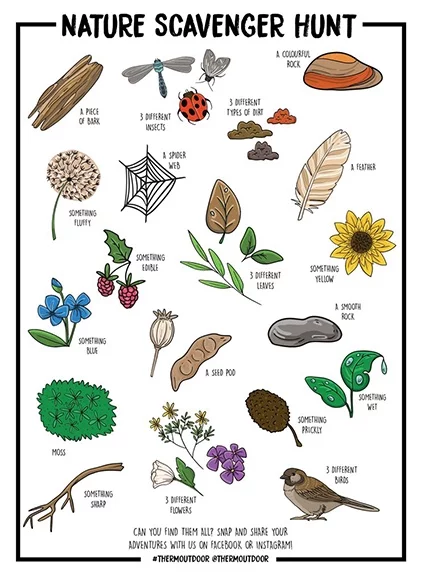
Materials needed:
- A list of nature items to find (either pre-made or created by you)
- Pen or pencil for each child
- Clipboard or paper (optional, to keep track of found items)
Instructions:
- Preparation: Before starting the game, create a list of nature items for the kids to find during the scavenger hunt. Consider the environment, season, and age of the children when selecting items for the list. Include a mix of easy-to-find items and more challenging ones to keep the game interesting. Some examples of nature items could be a specific type of leaf, a pinecone, a smooth rock, a feather, or a wildflower.
- Explain the game: Gather the kids and explain the rules of the Nature Scavenger Hunt. Provide each child with a list of items they need to find and a pen or pencil to check off the items as they find them.
- Set boundaries and time limits: To ensure the kids stay within a safe area and don’t wander off, establish clear boundaries for the scavenger hunt. Depending on the age of the children and the size of the area, you can also set a time limit for the game.
- Start the scavenger hunt: Once the rules, boundaries, and time limits have been established, let the kids begin their hunt for the nature items on their list. Encourage them to observe their surroundings closely and use their senses to find the items.
- Optional: Divide the kids into teams or pairs to promote teamwork and cooperation. You can also create a points system based on the rarity or difficulty of the items to make the game more competitive.
- Finish the scavenger hunt: When the time is up or the kids have found all the items on their list, gather them together to discuss their discoveries. Ask each child to share their favorite find and what they learned about it.
- Optional: Turn the scavenger hunt into a learning opportunity by having the kids research or discuss the items they found. They can learn about the plants, animals, and other natural elements they encountered during the game.
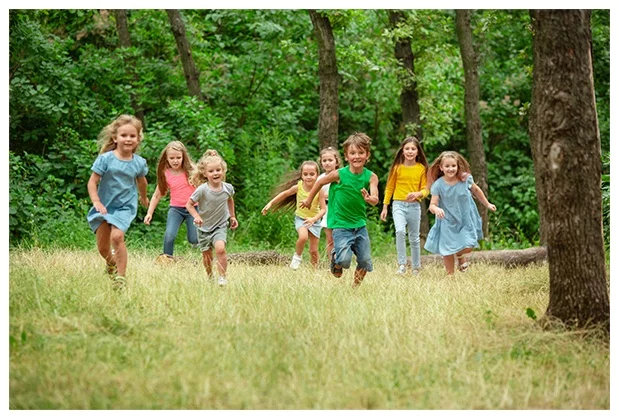
4. Camping Olympics
If you are into sports, you can easily organize Camping Olympics. You can come up with hundreds of camp game and sports ideas.
Camping Olympics will turn your camping trip into one of the most fun days or weekends you have had as a family. You can do long jump, relay races, and swimming competitions. You have everything you need. For example, you can do a long jump and similar sports on the sandy beach. And then you have an open area for relay races.
Materials needed:
- Various materials for different Olympic events (such as balls, Frisbees, cones, rope, etc.)
- Paper and pen for scoring
- Stopwatch or timer
- Medals, ribbons, or certificates for winners (optional)
Instructions:
- Preparation: Before starting the Camping Olympics, decide on the Olympic events you’d like to include. Choose a mix of physical, mental, and teamwork-based activities to keep the competition engaging and fun for everyone. Some examples of events are:
- Relay races
- Tug-of-war
- Obstacle courses
- Sack races
- Water balloon toss
- Nature trivia
- Scavenger hunts
- Frisbee golf
- Set up the events: Once you’ve selected the events, set up the necessary materials and equipment at different stations around the campsite.
- Explain the game: Gather the kids and explain the concept of Camping Olympics. Divide them into teams or allow them to compete individually, depending on the chosen events and the number of participants.
- Establish rules and scoring: Explain the rules for each event and how the scoring system will work. For example, you could assign points based on the team’s or individual’s performance in each event, with the highest total points determining the winner.
- Start the Camping Olympics: Begin the competition by having the kids participate in the first event. Rotate through the various events, giving each team or individual the opportunity to compete in every activity.
- Keep track of scores: As the kids complete each event, record their scores on a piece of paper. Make sure to keep track of the scores for each team or individual throughout the competition.
- Finish the Camping Olympics: Once all the events have been completed, tally up the scores to determine the winners. Gather the kids together to announce the winners and celebrate their achievements.
- Optional: Award medals, ribbons, or certificates to the winners in a fun awards ceremony. This can help create a sense of accomplishment and encourage sportsmanship among the participants.
5. Squirt Gun Races
Here is another race you can organize while enjoying your camping holiday. For this game, you will need to make a line of empty plastic drinking cups along the edge of a picnic table.
Then, fill a squirt gun with water. When the “judge” says go, contestants must squirt the cups until they fall off the edge of the table.
You can have multiple players playing the game and see who wins by knocking the most cups off. Another option is to time the game and see who clears the table in the shortest amount of time.
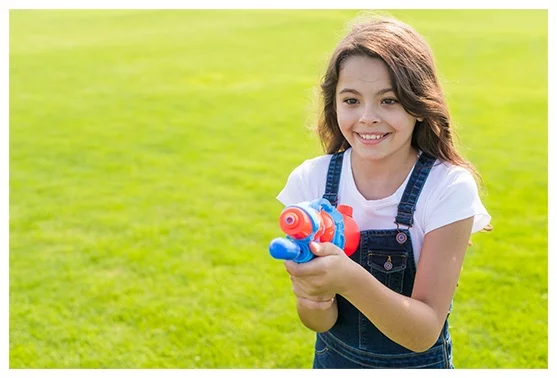
Materials needed:
- Squirt guns (one for each child)
- Lightweight plastic cups or ping pong balls
- A long table or flat surface
- Water source for refilling squirt guns
- Buckets or large containers (optional, for water relay races)
Instructions:
- Preparation: Before starting the game, set up a long table or flat surface outdoors. Place lightweight plastic cups or ping pong balls at one end of the table. Fill the squirt guns with water and make sure there’s a water source nearby for refilling during the game.
- Explain the game: Gather the kids and explain the objective of Squirt Gun Races. The goal is to use the squirt guns to propel the cups or balls from one end of the table to the other.
- Divide into teams or play individually: Depending on the number of participants and squirt guns, you can divide the kids into teams or let them play individually. If playing in teams, each team will need a designated spot at the table.
- Start the race: Line the kids up at one end of the table, making sure each child has a squirt gun. On the count of three, have the kids start squirting their guns at the cups or balls, trying to move them across the table as quickly as possible.
- Declare the winner: The first child or team to successfully move their cup or ball from one end of the table to the other wins the race.
- Optional variations: You can introduce different challenges and variations to Squirt Gun Races, such as:
- Setting up an obstacle course on the table that the cups or balls must navigate through.
- Having a water relay race where kids must transfer water from one bucket to another using only their squirt guns.
- Creating a target shooting game by setting up various targets at different distances and having kids aim their squirt guns at them.
6. Corn Hole
We love this lawn game because anyone can play it. It’s easy and simple. In this camping game, players take turns throwing 16-ounce bags of corn kernels at a raised platform with a hole in the far end. The scores are as following: bag in the hole equals three points, and bag on the board equals one point.
Materials needed:
- Two Corn Hole boards (either store-bought or homemade)
- Eight bean bags (four for each team, preferably in two different colors)
- Measuring tape or a pre-determined distance marker
Instructions:
- Set up the boards: Place the Corn Hole boards opposite each other at a pre-determined distance (typically 27 feet apart for adults, but you can adjust the distance based on the age and skill level of the children). The boards should be facing each other, with the holes at the top of each board.
- Divide into teams: Divide the kids into two teams, with each team having four bean bags of the same color.
- Explain the game: Explain the rules of Corn Hole to the kids. The objective is to toss the bean bags onto the opposing team’s board or into the hole to score points. Each bean bag that lands on the board is worth one point, while each bean bag that goes through the hole is worth three points.
- Determine the order of play: Have each team decide who will throw first. Players from each team will alternate turns, with one player from each team throwing all four of their bean bags before the other team’s turn begins.
- Start the game: Have the first player from Team A stand next to their Corn Hole board and toss one bean bag at a time towards the opposing team’s board. After all four bean bags have been thrown, the first player from Team B will do the same.
- Scoring: After both players have thrown their bean bags, calculate the score for that round. Only one team can score points in each round. To determine the score, subtract the lower team’s points from the higher team’s points. For example, if Team A scores 5 points and Team B scores 3 points, Team A earns 2 points for that round.
- Continue the game: Play continues with the next players in line for each team, following the same rules and scoring system. The game ends when one team reaches or exceeds a pre-determined number of points (typically 21), but you can adjust the winning score based on the kids’ skill level and the time available.
- Celebrate the winner: Congratulate the winning team and encourage good sportsmanship among all participants.
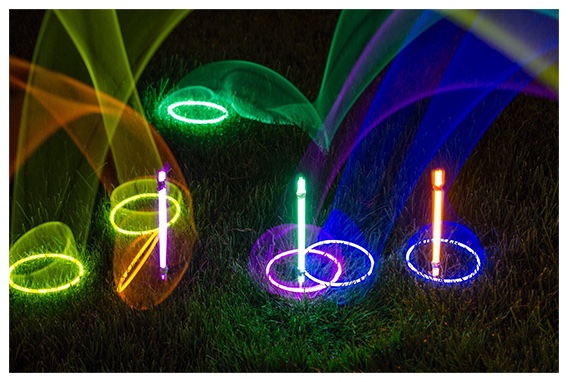
7. Glowing Ring Toss
Here are some nighttime camping games for kids. This game caters to your kids’ love for glow sticks. They will surely enjoy playing it.
Kids love glow sticks, and we can turn that love into an entertaining outdoor game. Use one large glow stick and a smaller bracelet-sized stick to create a glowing ring toss game.
If you want to make it more challenging, use three large sticks and place them at different distance and height. Assign a range of point values to each stick.
Materials needed:
- Glow sticks (enough to create several rings and one or more targets)
- Connectors for glow sticks (usually included when purchasing glow sticks)
- A stake or pole to serve as the target post (optional)
Instructions:
- Preparation: Activate the glow sticks by bending and shaking them until they start glowing. Use the connectors to create rings with some of the glow sticks. With the remaining glow sticks, create one or more targets by connecting them into a larger ring or using a stake or pole as the target post. If using a stake or pole, wrap a glow stick around it or use connectors to attach it.
- Set up the game: Choose a flat area outdoors to set up the Glowing Ring Toss. Place the target(s) on the ground or insert the stake or pole into the ground at a suitable distance from the throwing line, depending on the age and skill level of the kids.
- Divide into teams or play individually: Depending on the number of participants and glow stick rings, you can divide the kids into teams or let them play individually.
- Explain the game: Explain the rules of Glowing Ring Toss to the kids. The objective is to toss the glowing rings onto the target(s) or around the target post to score points. You can assign different point values to each target or make it a simple one-point-per-ring game.
- Start the game: Have the first player stand behind the throwing line and toss their glowing rings, one at a time, towards the target(s). Players take turns throwing their rings and trying to land them on or around the targets.
- Scoring: After all players have thrown their rings, tally up the points earned by each player or team based on the rings that successfully landed on the targets or around the target post.
- Continue the game: Play several rounds of Glowing Ring Toss, giving each player or team multiple opportunities to score points. The game can continue for a set number of rounds or until a certain score is reached.
- Declare the winner: Announce the player or team with the highest score as the winner and celebrate their success.
8. Campfire Story Contest
Not all camping games should include activities like running around or jumping around. Some games allow the kids to sit and help them calm down.
This one, for example, plays into your kids’ natural love for storytelling. Ask any kid to tell you a story, and they can go on for hours.
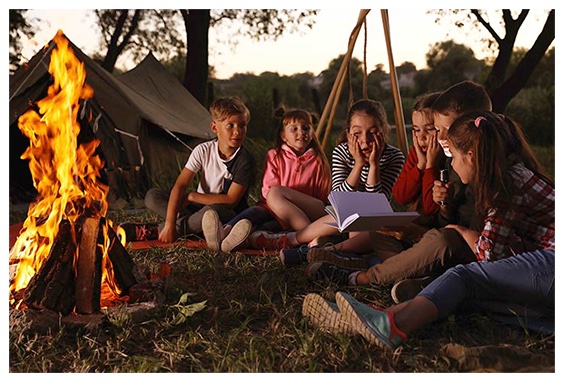
Materials needed:
- A campfire or fire pit (always follow safety guidelines and campsite rules when building a fire)
- Seating around the campfire for all participants
- A timer or stopwatch (optional)
- Prizes or certificates for the winners (optional)
Instructions:
- Preparation: Set up a campfire or fire pit in a safe and suitable location, following campsite rules and safety guidelines. Ensure that there is enough seating around the campfire for all participants.
- Explain the game: Gather the kids around the campfire and explain the concept of the Campfire Story Contest. Each participant will have a chance to tell a story, which can be real or fictional, to entertain and captivate their audience.
- Set guidelines and time limits: Establish guidelines for the stories, such as appropriate themes and content. Depending on the number of participants and the time available, set a time limit for each story (e.g., 3-5 minutes).
- Begin the contest: Have the first participant start their story. Encourage the other kids to listen attentively and respectfully while the story is being told. Once the first story is complete, move on to the next participant.
- Optional: Use a timer or stopwatch to keep track of the time for each storyteller, ensuring that everyone adheres to the time limit.
- Judging the contest: After all the participants have told their stories, it’s time to choose the winners. You can select the winners based on criteria such as creativity, storytelling skills, and audience engagement. You can also involve the kids in the judging process by having them vote for their favorite stories.
- Announce the winners: Congratulate the winners and acknowledge the efforts of all participants. Encourage good sportsmanship and praise the creativity and storytelling skills displayed by the kids.
- Optional: Award prizes or certificates to the winners to celebrate their storytelling achievements.

9. Flashlight Tag
Here is another camp game you can play as the night arrives. Once the campsite gets dark, take out your flashlights.
One person is the “tagger.” You give him a flashlight and then play tag as you normally would. The only difference is the tagger uses the light of the flashlight for tagging.
Once a player gets hit with the light, he is out of the game. The game then continues until everyone has been caught.
Materials needed:
- Flashlights (one for the person who’s “it” and extras for younger or less experienced players, if desired)
- A designated outdoor play area with hiding spots (preferably away from hazards and potential dangers)
- Fully charged batteries for the flashlights
Instructions:
- Preparation: Choose a designated outdoor play area with hiding spots for the kids to play Flashlight Tag. Ensure that the area is safe and free of potential hazards, such as holes, rocks, or tripping hazards. Make sure each flashlight is working and has fully charged batteries.
- Explain the game: Gather the kids and explain the rules of Flashlight Tag. The objective is for the person who’s “it” to find and “tag” other players using the beam of the flashlight. When a player is tagged, they become “it” and take over the flashlight.
- Choose the first “it”: Select one child to be the first “it” by using a method like “Rock, Paper, Scissors,” drawing straws, or having a volunteer.
- Start the game: Give the first “it” player the flashlight and have them count to a pre-determined number (e.g., 30) with their eyes closed, allowing the other players time to hide. Once the countdown is over, the “it” player can begin searching for the other players using the flashlight.
- Tagging players: When the “it” player spots someone, they must shine the flashlight beam on the player and call out their name to “tag” them. The tagged player then becomes the new “it,” and the game continues.
- Optional rules: For younger kids or those who may be afraid of the dark, you can provide additional flashlights so they can feel more secure while playing. Alternatively, you can establish “safe zones” where players can’t be tagged, or create a time limit after which players can return to a designated “home base” without being tagged.
- End the game: Continue playing until everyone has had a chance to be “it” or until the kids tire of the game. Congratulate all participants for their efforts and encourage good sportsmanship.
10. Mosquito Bites
If there is one thing we all hate about camping, it’s mosquitos. You cannot have it any other way. Mosquitos are part of the experience.
But instead of complaining, we have a family camping game you can use to remember to use mosquito repellent. So, how do you play this game?
Materials needed:
- A soft and lightweight ball (such as a foam or soft rubber ball) to represent the “mosquito”
- An open outdoor space free of hazards and obstacles
Instructions:
- Preparation: Choose a suitable open outdoor space for the kids to play Mosquito Bites. Make sure the area is free of hazards and obstacles that could cause injury.
- Explain the game: Gather the kids and explain the rules of Mosquito Bites. The objective is to avoid being “bitten” by the “mosquito” (the ball). The person holding the ball is the “mosquito,” and they will try to tag other players by gently tossing the ball at them.
- Choose the first “mosquito”: Select one child to be the first “mosquito” using a method like “Rock, Paper, Scissors,” drawing straws, or having a volunteer.
- Start the game: The first “mosquito” takes the ball and begins to chase the other players, attempting to tag them by tossing the ball gently at them. Players must avoid being hit by the ball while staying within the designated play area.
- Tagging players: When a player is “bitten” (hit) by the “mosquito” (the ball), they become the new “mosquito” and take the ball, continuing to chase and tag other players.
- Safety rules: Remind players to be careful not to throw the ball too hard and to avoid aiming at others’ heads. Encourage good sportsmanship and fair play.
- End the game: Continue playing until everyone has had a chance to be the “mosquito” or until the kids tire of the game. Congratulate all participants for their efforts and encourage good sportsmanship.

11. Capture the Flag
Almost any video game back in the day had an option for capture-the-flag gameplay. It is a common game, one that combines speed, stamina, and brains. It makes it more challenging to win.
What are the rules? Well, you split into two teams and then designate an area for each team. You give each team a flag to keep in their area. The goal of the game is to find the other team’s flag and bring it back to your territory.
Materials needed:
- Two flags or items to represent flags (e.g., bandanas, colored cloth, or small bags)
- A spacious outdoor area with natural boundaries (e.g., trees, bushes, or rocks) to separate the teams’ territories
- Optional: Cones, rope, or other markers to define the boundaries of each team’s territory
Instructions:
- Preparation: Choose a spacious outdoor area for the game and divide it into two equal territories using natural boundaries or markers. Place each team’s flag at a designated location within their territory, ensuring it is visible but challenging to reach.
- Divide into teams: Split the kids into two equally matched teams. Assign each team a color or name to distinguish them.
- Explain the game: Gather the kids and explain the rules of Capture the Flag. Each team’s goal is to enter the opposing team’s territory, capture their flag, and bring it back to their own territory without being tagged.
- Establish the rules: Define the tagging rules, such as whether players can only tag opponents in their own territory or if they can tag anywhere. Decide what happens when a player is tagged (e.g., they must return to their territory, go to a designated “jail” area, or sit out for a short period).
- Start the game: Have the teams begin the game by strategizing and sending players into the opposing team’s territory to capture their flag.
- Capturing the flag: When a player successfully captures the opposing team’s flag, they must carry it back to their own territory without being tagged. If the player is tagged while carrying the flag, they must drop the flag, and it is returned to its original location.
- Freeing jailed teammates: If your rules include a designated “jail” area for tagged players, you can allow teammates to free jailed players by tagging them. Freed players must then return to their territory before resuming play.
- Winning the game: The game continues until one team successfully captures the opposing team’s flag and brings it back to their territory. Congratulate the winning team and encourage good sportsmanship among all participants.
12. Camping Bingo
You can never go wrong with bingo, right? But the camping version is a bit different. You give each player a bingo card. Then, each player marks off his camping bingo square when he finds an item on the list.
Since you are in nature, you can use items like stones, leaves, and similar things. Think of this fun camping game as a scavenger hunt, only with a list of items you need to find and win bingo.
Just remember to teach your kids the “leave no trace” principle. Basically, they only mark off items but they don’t remove them from nature.

Materials needed:
- Pre-made bingo cards with camping and nature-related items or activities (e.g., find a pinecone, spot a bird, identify a plant, or set up a tent)
- Writing utensils (pencils or pens) for marking off completed items or activities on the bingo cards
- Optional: Small prizes or rewards for winners
Instructions:
- Preparation: Before the camping trip, create bingo cards with a 5×5 grid, featuring camping and nature-related items or activities in each square. Make enough cards for each child participating in the game. You can find pre-made camping bingo cards online or create your own based on the camping location and expected wildlife or flora.
- Explain the game: Gather the kids and explain the rules of Camping Bingo. The objective is to find items or complete activities on their bingo cards and mark them off until they complete a row, column, or diagonal line.
- Hand out the bingo cards: Distribute the bingo cards and writing utensils to each child. Encourage them to explore their surroundings and work on completing their bingo cards.
- Supervise and assist: While the kids are playing, supervise and provide assistance when needed. Help younger children with identifying plants or animals and ensure that everyone stays within safe boundaries during their exploration.
- Encourage teamwork: Although Camping Bingo is a competitive game, remind the kids to help each other with identifying items or completing activities. Encourage teamwork and cooperative play.
- Completing a bingo: When a child completes a row, column, or diagonal line on their bingo card, they should call out “Bingo!” Verify that the items or activities have been found or completed correctly.
- Declaring a winner: Congratulate the first child to complete a bingo and encourage the other kids to continue playing until they have also achieved a bingo.
- Optional: Award small prizes or rewards to the winners to celebrate their achievements.
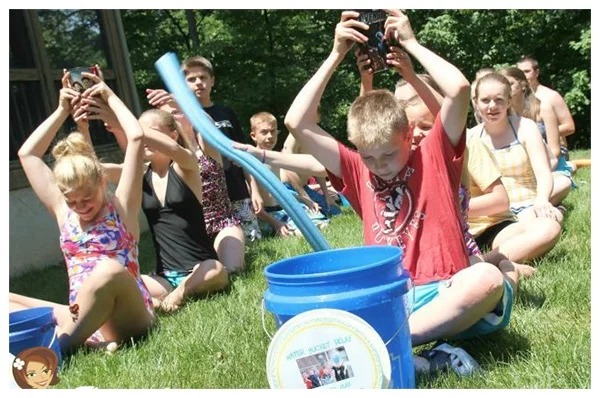
13. Water Relay
When you camp during summer or spring, hot days are part of the experience. How can you cool down during these times? Well, going for a swim is one option.
Another option is to play some water games. Let’s try water relay, OK?
Materials needed:
- Two large containers or buckets (one for each team) to hold water at the start point
- Two smaller containers (e.g., cups or small buckets) for transporting water
- Two empty large containers or buckets placed at the end point
- A spacious outdoor area to set up the relay course
Instructions:
- Preparation: Choose a spacious outdoor area and set up the relay course by placing the large containers filled with water at the start point and the empty large containers at the end point. Make sure there’s enough space between the start and end points for the kids to run and carry water.
- Divide into teams: Split the kids into two evenly matched teams.
- Explain the game: Gather the kids and explain the rules of Water Relay. The objective of the game is for each team to transport water from the starting container to the empty container at the end point as quickly as possible using the smaller containers.
- Position the teams: Have each team line up behind their starting container filled with water. Give the first player in each line one of the smaller containers for transporting water.
- Start the relay: On your signal, the first player in each line should fill their smaller container with water from the starting container, run to the end point, and pour the water into the empty container. They should then run back to their team, hand off the smaller container to the next player in line, and go to the back of the line.
- Continue the relay: The next player in line repeats the process, filling their smaller container, running to the end point, and pouring the water into the empty container. The relay continues until every player on the team has had a turn.
- Declare a winner: The game ends when one team successfully fills their empty container at the end point. Congratulate the winning team and encourage good sportsmanship among all participants.
14. Sleeping Bag Race
This game makes it to almost every camping movie. If you see a movie and there is a camping trip in it, you can be sure they will play the sleeping bag race. It is one of the most fun and entertaining camp games.
Relay races top the list for outdoor kids’ party games. It’s the same as the classic potato sack race, only you use sleeping bags. Kids can play it anyway they like it. They can jump inside of their sleeping bag. Or, another option is to get into them on the ground and crawl to the finish line.
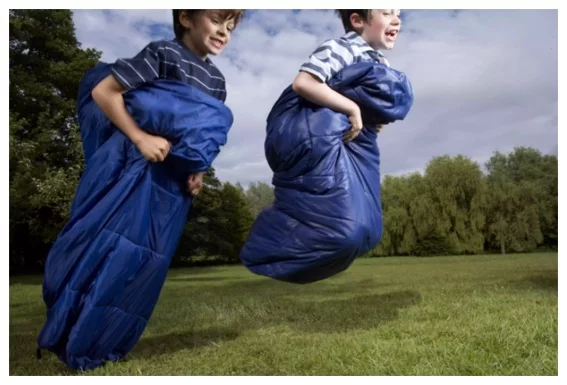
Materials needed:
- One sleeping bag per participant
- A spacious outdoor area to set up a racecourse
- Cones, rope, or other markers to define the start and finish lines
Instructions:
- Preparation: Choose a spacious outdoor area to set up the racecourse. Use cones, rope, or other markers to define the start and finish lines, ensuring there’s enough space between them for the kids to race.
- Explain the game: Gather the kids and explain the rules of Sleeping Bag Race. The objective is to hop or shuffle from the start line to the finish line inside a sleeping bag as quickly as possible.
- Position the participants: Have each child stand at the start line with their sleeping bag. Instruct them to step inside the bag and pull it up around their waist, holding the edges of the bag with their hands.
- Start the race: On your signal, the kids should begin hopping or shuffling towards the finish line while remaining inside their sleeping bags. Encourage them to go as fast as they can while maintaining their balance and staying within their sleeping bags.
- Declare a winner: The first child to cross the finish line while still inside their sleeping bag is the winner. Congratulate the winner and encourage good sportsmanship among all participants.
- Multiple races or relay: If you have a large group of kids, consider organizing multiple races or turning the Sleeping Bag Race into a relay by having teams take turns racing to the finish line and back.
15. Charades
Let’s try another brain game for kids. Charades is one of the simplest yet most entertaining games. You probably know the rules. People write down clues on a piece of paper. Players then act them out and get their teammate to guess the clue without saying a word. Once you master the simple version, you can try the celebrity version of charades.
Materials needed:
- Pre-made word or phrase cards with categories suitable for kids (e.g., animals, movies, books, or camping-related items)
- A container or bag to hold the word or phrase cards
- A timer or stopwatch
- Optional: Pen and paper for keeping score
Instructions:
- Preparation: Before the camping trip, prepare a set of word or phrase cards with categories suitable for kids. Make sure the words or phrases are age-appropriate and can be easily acted out.
- Divide into teams: Split the kids into two or more evenly matched teams.
- Explain the game: Gather the kids and explain the rules of Charades. One player from a team will draw a word or phrase card from the container and act it out without speaking or making any noises, while their teammates try to guess the word or phrase within a specified time limit (e.g., 1 or 2 minutes).
- Choose the first actor: Select one child from the first team to be the first actor using a method like “Rock, Paper, Scissors,” drawing straws, or having a volunteer.
- Start the timer: Begin the timer or stopwatch once the actor has drawn a word or phrase card and is ready to start acting it out
- Guessing and acting: The actor’s teammates should call out their guesses as the actor acts out the word or phrase. The actor can use gestures, such as pointing to objects or miming actions, but they cannot speak or make any noises. Encourage the actor to be creative and expressive in their actions.
- Successful guessing: If the actor’s teammates successfully guess the word or phrase within the time limit, their team earns a point. If the time runs out before they guess the correct word or phrase, no points are awarded.
- Switch teams: Once a team’s turn is over, the other team takes their turn, with a new actor drawing a word or phrase card and acting it out for their teammates to guess.
- Continue playing: Continue alternating between teams until each child has had a turn to act, or for a predetermined number of rounds.
- Declare a winner: The team with the most points at the end of the game is the winner. Congratulate the winning team and encourage good sportsmanship among all participants.
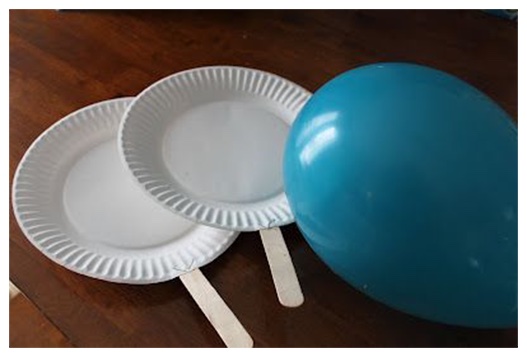
16. Balloon Ping Pong
Let’s try some balloon games, can we? You can play this one over a picnic table with simple supplies. Balloon ping pong will be one of the most entertaining parts of your camping experience.
Just make sure to bring along extra balloons.
Materials needed:
- Inflated balloons (one per game or extras as needed)
- Ping pong paddles, fly swatters, or paper plates with handles (one per player)
- A table, net, or rope to serve as the playing surface or divider
- Optional: Cones or other markers to define the playing area
Instructions:
- Preparation: Choose a spacious outdoor area to set up the Balloon Ping Pong game. Place a table or set up a net or rope to serve as the playing surface or divider. If using a net or rope, mark the playing area boundaries with cones or other markers.
- Divide into teams: Split the kids into two evenly matched teams. Each team should stand on opposite sides of the playing surface or divider.
- Explain the game: Gather the kids and explain the rules of Balloon Ping Pong. The objective is to hit the balloon with a paddle or fly swatter, sending it over the playing surface or divider and into the opposing team’s area. The opposing team must then hit the balloon back over without letting it touch the ground.
- Start the game: Have one team start by serving the balloon. The server should gently toss the balloon into the air and hit it with their paddle or fly swatter, sending it over the playing surface or divider.
- Playing the game: Each team should work together to keep the balloon in the air and send it back over to the opposing team’s area. Players can only hit the balloon once before another teammate must hit it, and the balloon cannot be caught or held.
- Scoring points: A team scores a point when the opposing team fails to return the balloon, or when the balloon touches the ground in the opposing team’s area. The serving team rotates after each point.
- Declaring a winner: The game continues until a predetermined number of points are scored (e.g., 10 or 21 points), and the team with the most points wins. Congratulate the winning team and encourage good sportsmanship among all participants.
17. Create a Nature Guidebook
When in Rome, do as the Romans do. Do you know that quote? Basically, it means to follow the conventions of the area you are visiting.
So, when you are in nature, you can encourage kids to be curious about nature. For this game, kids need to learn the names and properties of the plants and animals around them.
Write them down in your guidebook. Do so for every place you visit. After a while, you can even compare the different natural finds in the places you have visited.

Materials needed:
- Notebooks or journals for each child (or a single shared guidebook for the group)
- Pencils, pens, or colored pencils for drawing and writing
- Optional: Field guides, magnifying glasses, or binoculars for observing nature
- Optional: Camera or smartphone for taking reference pictures
Instructions:
- Preparation: Provide each child with a notebook or journal for creating their Nature Guidebook. If you prefer, you can create a single shared guidebook for the entire group. Assemble additional materials, such as pencils, pens, colored pencils, field guides, magnifying glasses, or binoculars.
- Explain the activity: Gather the kids and explain the objective of creating a Nature Guidebook. They will explore the environment around the campsite, looking for interesting plants, animals, rocks, or other natural features. They will then document their findings in their guidebooks by writing descriptions and drawing pictures.
- Set boundaries: Establish clear boundaries for the kids to explore within, ensuring they remain within a safe distance from the campsite and each other. Encourage them to stay on marked trails and respect the environment by not disturbing plants or wildlife.
- Observe and document: Encourage the kids to observe the natural world around them and take notes, draw pictures, or take reference photos of the plants, animals, or other interesting features they find. They can use field guides, magnifying glasses, or binoculars to help them identify and study their findings.
- Share discoveries: As the kids explore and document their findings, encourage them to share their discoveries with each other, discussing what they’ve learned and comparing their observations.
- Review the guidebooks: At the end of the activity, gather the kids together and have them share their Nature Guidebooks with the group. Encourage them to discuss what they learned, the challenges they faced, and their favorite parts of the experience.
18. 20 Questions
Here is another camping game that stimulates your kids’ brain activity. It is a classic guessing game. Basically, players can ask 20 questions, and the person in charge answers only with Yes or No.
After the 20 questions, or at any point during, players can guess the term. Make the object camping-themed.
Instructions:
- Explain the game: Gather the kids and explain the rules of 20 Questions. One player will think of an object, person, or place (called the “chosen subject”), while the other players take turns asking yes or no questions to determine what the chosen subject is. The players have a total of 20 questions to guess the chosen subject correctly.
- Choose the first thinker: Select one child to be the first thinker using a method like “Rock, Paper, Scissors,” drawing straws, or having a volunteer. The thinker should think of an object, person, or place but should not reveal their choice to the other players.
- Start asking questions: The other players take turns asking yes or no questions to gather information about the chosen subject. The thinker must answer truthfully and can only respond with “yes,” “no,” or “I don’t know.”
- Make guesses: Players can make a guess at any time during their turn. If a player guesses the chosen subject correctly, they become the next thinker. If no one correctly guesses the chosen subject within 20 questions, the thinker wins and can either reveal the answer or give the group a hint and continue for a few more questions.
- Continue playing: The game continues with new thinkers and chosen subjects, allowing each child the opportunity to be the thinker and ask questions. Encourage the kids to think of a variety of objects, people, or places to keep the game interesting and challenging.
- Encourage teamwork: If you have a large group of kids, consider dividing them into smaller teams to collaborate on asking questions and making guesses. This promotes teamwork, communication, and shared problem-solving skills.
- Adapt for younger players: For younger children, you can simplify the game by limiting the categories of the chosen subject (e.g., only animals, plants, or camping-related items) or by allowing more questions.
19. Air Pong
This game is a fun take on the classic tug of war game. Same as for tug of war, you have to divide players into two groups.
Then, have each group stand on the opposite side of a picnic table with their hands behind their back. Once players are ready, place a polystyrene cup, ping pong ball, or a similar ball in the center of the table. On “go,” teams have to blow the cup/ball off the opposite team’s side of the table.
Materials needed:
- A lightweight ball or inflated balloon
- A net, rope, or some kind of divider to separate the playing area
- Cones or other markers to define the playing area boundaries (optional)
Instructions:
- Preparation: Choose a spacious outdoor area to set up the Air Pong game. Set up a net or rope to serve as the divider between the two playing areas. If using a rope, mark the playing area boundaries with cones or other markers.
- Divide into teams: Split the kids into two evenly matched teams. Each team should stand on opposite sides of the playing surface or divider.
- Explain the game: Gather the kids and explain the rules of Air Pong. The objective is to hit the lightweight ball or balloon with their hands, sending it over the divider and into the opposing team’s area. The opposing team must then hit the ball or balloon back over without letting it touch the ground.
- Start the game: Have one team start by serving the ball or balloon. The server should gently toss the ball or balloon into the air and hit it with their hand, sending it over the divider.
- Playing the game: Each team should work together to keep the ball or balloon in the air and send it back over to the opposing team’s area. Players can hit the ball or balloon as many times as needed to return it over the divider, but they must not catch or hold it.
- Scoring points: A team scores a point when the opposing team fails to return the ball or balloon, or when the ball or balloon touches the ground in the opposing team’s area. The serving team rotates after each point.
- Declare a winner: The game continues until a predetermined number of points are scored (e.g., 10 or 21 points), and the team with the most points wins. Congratulate the winning team and encourage good sportsmanship among all participants.

20. Bear Catcher
Let’s just hope this game doesn’t turn into a realistic scenario, right? Jokes aside, the bear catcher is a fun game you can play. It is a tweak on the classic tag game.
One player is the bear catcher, and all other players are bears. You place a sleeping bag for each bear around the campsite. The sleeping bag is basically the bear cave. The bear catcher stands in the center of the play area. When a non-player says “go,” bears must race to a new cave before the bear catcher can tag them.
Instructions:
- Explain the game: Gather the kids and explain the rules of Bear Catcher. One player will be the “bear,” and the other players will be “campers.” The bear’s objective is to catch the campers, while the campers try to avoid being caught by the bear.
- Choose the first bear: Select one child to be the first bear using a method like “Rock, Paper, Scissors,” drawing straws, or having a volunteer.
- Set boundaries: Establish clear boundaries for the play area, ensuring there’s enough space for the kids to run and maneuver safely. Make sure the area is free of potential hazards like rocks, holes, or uneven surfaces.
- Start the game: The bear begins at a designated “bear den” area, while the campers spread out within the play area. The bear counts down from a predetermined number (e.g., 10 or 20) to give the campers time to position themselves.
- Catching campers: After counting down, the bear leaves their den and tries to tag the campers by gently touching them. Campers must avoid being caught by running, dodging, or hiding.
- Caught campers: When a camper is caught, they must “hibernate” by standing still with their arms out to their sides, legs spread, and head down. They can only be freed by another camper who crawls between their legs.
- Switching roles: If the bear catches all the campers, they win the round, and a new bear is chosen for the next round. If the bear is unable to catch all the campers within a predetermined time limit, the camper who has been hibernating the longest becomes the new bear.
- Continue playing: Play several rounds, allowing each child the opportunity to be the bear and a camper.
21. Canteen Bucket Brigade
Canteen Bucket Brigade is a water-based team relay game that’s perfect for a hot day during a camping trip. The objective is for teams to work together to transfer water from one container to another using only their canteens, while racing against other teams.
Here’s a detailed guide on how to play Canteen Bucket Brigade with kids:
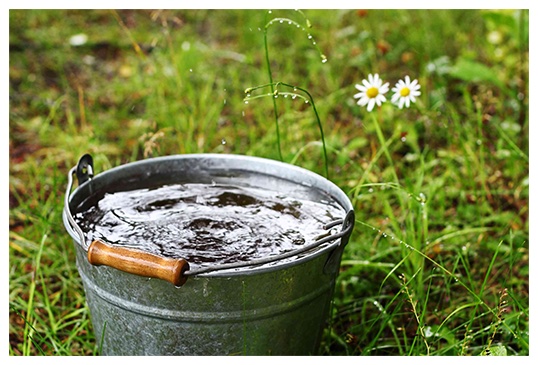
Materials needed:
- Two large containers (e.g., buckets, tubs, or coolers) filled with water
- Two empty containers of the same size as the filled ones
- One canteen, cup, or small container for each child
- Cones or other markers to define the playing area boundaries (optional)
Instructions:
- Preparation: Choose a spacious outdoor area to set up the Canteen Bucket Brigade game. Place the filled containers at one end of the playing area and the empty containers at the opposite end, with enough space in between for kids to run.
- Divide into teams: Split the kids into two evenly matched teams. Each team should line up single-file between the filled and empty containers, with each child holding their canteen, cup, or small container.
- Explain the game: Gather the kids and explain the rules of Canteen Bucket Brigade. The objective is for teams to work together to transfer water from the filled container to the empty container using only their canteens. The teams must race against each other, and the first team to fill their empty container to a predetermined level or the team with the most water in their container after a set time limit wins.
- Start the game: Have the first child in each team’s line fill their canteen with water from the filled container. They must then run to the empty container, pour the water into it, and run back to pass the canteen to the next child in line.
- Continue the relay: Each child takes turns filling their canteen, running to the empty container, pouring the water in, and passing the canteen to the next teammate. The process continues until the empty container is filled to the predetermined level or the time limit is reached.
- Declare a winner: The team that fills their empty container to the predetermined level first, or has the most water in their container when the time limit is reached, wins the game. Congratulate the winning team and encourage good sportsmanship among all participants.

22. Campfire Relay
If you are into racing, there is another game you can play. And the best part is, this game is practical. You set up two sets of supplies for building a campfire. You know — the basics: paper, wood, rocks.
On the word go, players have to race to gather supplies and build their own campfire. The first team to complete the campfire wins the race.
Materials needed:
- Several sticks, twigs, or small branches (or use alternatives like pool noodles or rolled-up newspapers)
- Two or more camping chairs, logs, or rocks to serve as “fire pits”
- Cones or other markers to define the playing area boundaries (optional)
Instructions:
- Preparation: Choose a spacious outdoor area to set up the Campfire Relay game. Place the “firewood” (sticks, twigs, branches, pool noodles, or rolled-up newspapers) at one end of the playing area, and the “fire pits” (camping chairs, logs, or rocks) at the opposite end, with enough space in between for kids to run.
- Divide into teams: Split the kids into two or more evenly matched teams. Each team should line up single-file at the end of the playing area where the “firewood” is located.
- Explain the game: Gather the kids and explain the rules of Campfire Relay. The objective is for teams to work together to collect and arrange the “firewood” in their “fire pit,” while racing against the other teams. The first team to complete their campfire or the team with the most “firewood” in their “fire pit” after a set time limit wins.
- Start the game: Have the first child in each team’s line pick up a piece of “firewood” and run to their team’s “fire pit.” They must then place the “firewood” in the “fire pit” and run back to tag the next child in line.
- Continue the relay: Each child takes turns running to the “fire pit,” placing the “firewood” in it, and running back to tag the next teammate. The process continues until all the “firewood” has been collected or the time limit is reached.
- Declare a winner: The team that collects and arranges all the “firewood” in their “fire pit” first, or has the most “firewood” in their “fire pit” when the time limit is reached, wins the game. Congratulate the winning team and encourage good sportsmanship among all participants.
23. Noah’s Ark
This game can help you learn a lot about animals. The game starts with a player saying “Into Noah’s Ark went one … ,” and then say an animal starting with “A.” For example, alpaca. The full saying would be “Into Noah’s Ark went one alpaca.”
The second player continues, but he says “Into Noah’s ark went one alpaca and two (starting with b), bald eagles.” The game continues until you make a mistake. Hopefully, you can make it all the way to Z.
24. Simon Says
Let’s finish our list of camping games for kids with the classic Simon Says. It is one of the favorite games for kids to play. One person is Simon. He tells other players what they must do. The trick is they must do only the commands beginning with “Simon says.”
For example, Simon Says get in a squat, players must get in a squat. But if he says make a squat, players should not obey the command. Those who don’t perform the command with “Simon says” or obey without it are out of the game.
